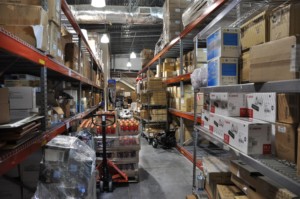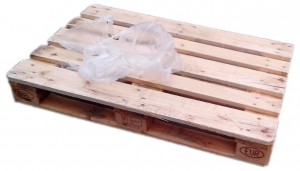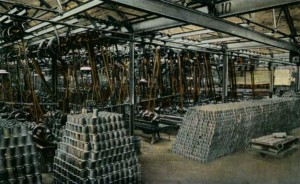 Lead time is a key factor for customer satisfaction, especially with make-to-order production. Hence, many companies want to reduce this lead time. In this blog post I show you the basic levers that influence your lead time, and a few more that may also apply to some cases. You have to find the combination of these levers that works best for you. This is the first post in a series of four posts on how to reduce lead time. Most of the series focuses on production, but the last post looks into reduction of lead time in development.
Lead time is a key factor for customer satisfaction, especially with make-to-order production. Hence, many companies want to reduce this lead time. In this blog post I show you the basic levers that influence your lead time, and a few more that may also apply to some cases. You have to find the combination of these levers that works best for you. This is the first post in a series of four posts on how to reduce lead time. Most of the series focuses on production, but the last post looks into reduction of lead time in development.
Introduction

The lead time is the time between a part or job entering the system and the time the completed product leaves the system. For make-to-order, this may also include other elements like development or purchasing. For make-to-order, the lead time defines the waiting time of the customer for his goods. For make-to-stock, it is slightly less relevant, since the goods are (ideally) already on stock. It may still make sense to reduce the lead time, however, for a faster information flow within the value chain. Since make-to-stock tries to reduce the inventory anyway, a reduction in lead time is often a nice side benefit.
The easiest way to determine your lead time is Little’s Law, as shown below. You simply divide your inventory (measured in pieces) by your throughput (measured in pieces per time) and get the lead time. Little’s Law is quite accurate and valid for pretty much all systems as long as they are somewhat stable. The inventory for Little’s Law includes not only the waiting inventory, but also the items that are currently processed. For more details, see my Eulogy for Little’s Law.
\[ { Lead Time = \frac{Inventory}{Throughput}} \]The lead time is significantly influenced by the utilization and the fluctuations of the system (arrival and processing fluctuations). While there is no accurate mathematical formula for real-world cases, the Kingman Formula is a good approximation of the waiting time for a single process with a single product type and a single queue. The formula is shown below, but for more details check my article on The Kingman Formula.
\[ { E(W) = \left ( \frac{p}{1-p} \right )\cdot \left ( \frac{ C_{a}^{2}+ C_{s}^{2} }{2} \right ) \cdot \mu_{s} } \]The Different Ways to Reduce Lead Time
 Overall, we have a couple of different ways to influence our lead time. Many of these are somewhat connected, so changing one may have beneficial side effects for another one too. One option is to reduce the inventory, which I will discuss in this blog post. My next post will look at the effects of fluctuations and the utilization. A third blog post will look at throughput and lot size. The final post in this series will look at the development process, where many of these effects are found again.
Overall, we have a couple of different ways to influence our lead time. Many of these are somewhat connected, so changing one may have beneficial side effects for another one too. One option is to reduce the inventory, which I will discuss in this blog post. My next post will look at the effects of fluctuations and the utilization. A third blog post will look at throughput and lot size. The final post in this series will look at the development process, where many of these effects are found again.
This blog post starts by looking at inventory, because this is the primary tool to reduce lead time. Even many of the other levers like fluctuations, utilization, and lot size reduce the lead time by reducing the inventory. This crucial role of inventory on lead time (and many other factors) is why lean pushes so hard to reduce inventory. Even the name lean comes from an inventory reduction.
Reduce Inventory
 Looking at Little’s Law, the best way way to reduce the lead time is to reduce the inventory. Sounds simple enough, but unfortunately it is not. Inventory does have a purpose in manufacturing, the biggest of which is to cover fluctuations. Others are to actually have a part to work on, and sometimes you can reduce cost by buying in bulk. For more see my post Why Do We Have Inventory?.
Looking at Little’s Law, the best way way to reduce the lead time is to reduce the inventory. Sounds simple enough, but unfortunately it is not. Inventory does have a purpose in manufacturing, the biggest of which is to cover fluctuations. Others are to actually have a part to work on, and sometimes you can reduce cost by buying in bulk. For more see my post Why Do We Have Inventory?.

Anyway, you can’t just reduce your inventory. If your inventory can no longer cover the fluctuations, you will be missing material more often, your utilization goes down, and your lead times may increase again. However, many companies have much more inventory than what they need to cover the fluctuations. Your first step is to figure out how much inventory you actually need … which is unfortunately not a precise science. To cover all fluctuations, you would need an infinite inventory, which is impossible. The inventory level is therefore always a trade-off between what fluctuations you want to cover and how much inventory you want to have.
This, in turn, is related to the importance of the utilization, fluctuations, lead time, and product availability. In general, make-to-stock systems have a higher inventory to ensure a high material availability. Make-to-order systems usually have a trade-off between the lead time and the utilization. In any case, you need to figure out your target inventory level.

Since this is an imprecise science, this is best observed in your real system. What material is always plenty in supply? Can you reduce it? What material is often out of stock? Should you increase it? Pull systems can help you both with determining a good inventory level, and with keeping your inventory at that level. If it would be a kanban system, you should determine how many kanban you need, and set up a kanban system.
Hence, your first step in reducing the lead time is to figure out how much inventory you actually need for your system. Subsequent steps addressing fluctuations, utilization, and lot sizes enable you to get away with even less inventory. But you should not have more inventory than what you actually need.
I hope this brief introduction to reducing the lead time by reducing the inventory to the actually required levels was helpful for you, although chances are you already suspected this relation. Nevertheless, I like to be thorough and start with the basics before going into more details in the next posts. Now, go out, reap the enormous benefits from reducing inventory, and organize your industry!
Series Overview
- Reducing Lead Time 1 – Inventory
- Reducing Lead Time 2 – Fluctuations and Utilization
- Reducing Lead Time 3 – Throughput and Lot Size
- Reducing Lead Time 4 – Development
P.S.: This series of posts is based on an inspiration by Rajan Suri, and also chapter 7 of his book Quick Response Manufacturing and chapter 3 from his book It’s About Time.
- Suri, Rajan. It’s About Time: The Competitive Advantage of Quick Response Manufacturing. 1 edition. New York: Productivity Press, 2010. ISBN 978-1-4398-0595-4.
- Suri, Rajan. Quick Response Manufacturing: A Companywide Approach to Reducing Lead Times. Portland, Oregon, USA: Taylor & Francis Inc, 1998. ISBN 978-1-56327-201-1.

Great blog Roser, always such a pleasure to read about operations here.
Don’t forget to mention another great book (or two)
Factory physics
https://www.amazon.com/dp/007123246X/
or
Factory physics for managers
https://www.amazon.com/dp/007182250X/
Br, Thomas
@Thomas, good books, I have em both. But they are not an easy read …
Hi Christopher,
You nicely and eloquently explained the topic of lead time and inventory reduction. As you said, for reducing lead time, one can reduce inventory by virtue of Little’s Law. But, in MTO production this applies to the case of averages, that is, the average lead time decreases with the average inventory.
I am very positive that a Pull system can be intelligently designed to ensure minimal WIP without any loss of throughput. It means the system can also ensure minimal average lead time of orders. But, in my opinion it will not practically help MTO units which are usually engaged in high-mix, low-volume production and need to reduce lead time for “each and every” individual order.
Since every customer of a job shop engaged in HMLV, MTO production demands minimal lead time for his specific order, the job shop must do more than minimization of the average lead time by inventory reduction. For this purpose, we need to go beyond the production logistical methods learnt from Toyota. No amount of commonsense and no literature can offer sufficient help either. In my opinion, good calculations help with minimization of lead time of each and every individual order in MTO production. Truly powerful scheduling software for job shops can perform such calculations instantaneously.
Prasad https://optisol.biz/
@Prasad, with lead time both the mean and the fluctuations are relevant to the company. If you reduce the average lead time, all of your deliveries will be faster. Of course, for MTO the deadline is also relevant, and the customer doesn’t care that much about the “lead time” but about the “on time“. As I have said before job shops are hard to manage. Flow shops would be easier, but may not always be possible.
Hi Christoph,
thank you for this clear explanation of Little’s Law and your demonstration of easiness of lead time calculation (given assumptions are obeyed).
However, I always wondered about its low dissemination. Use of system data or even manual time measurements of products running through the system is often preferred instead.
For sure your blog will help to spread the word.
Besides that – Little’s Law and lean principles also apply to MTO and low volume manufacturing systems (given assumptions are obeyed). Would you agree?
@Helmuth, the beauty of little’s law is its wide validity. It does not matter what type of distribution you have for arrival or departure, what type of system (flow/job shop), what sequence, how big your system is, and many other things, Little’s law is not an approximation but precise! We don’t get precise equations that often in lean, most are approximations and estimations. Hence i even wrote A Eulogy for Little’s Law.
The only thing that can throw Little’s law off is if the numbers have a trend over time. If your queue gets longer and longer, or your system slower and slower, or parts arrive less and less, (or the opposites), the equation is no longer precise.
Thank you Chris for your series on reducing lead times & for the comments of Prasad. I follow both of you and there is aIways something insightful to be gained from a revisit of these topcis. I work in an MTO environment , Fashion apparel manufacturing – and the industry is truly turning to Low volume, High variety. The challenge is further accentuated by the fact that purchasing lead times are high and Raw materials change from order to order .Look forward to the entire series
When reducing your inventory to focus on shortening lead times the pull system was mentioned. In order to reduce excess inventory and establish an accurate benchmark for inventory levels, the pull system is an effective method in safely managing inventory based on popularity and stockouts but is it still a safe and effective way of cutting down on lead times and inventory during the pandemic? With even more uncertain forecasts will the pull system help allocate inventory towards products with higher demand compared to products with lower demand?
Pull systems are great for controlling your inventory, which in turns defines (most of) your lead time. However, the amount of inventory you need depends a lot on other factors, the inventory level in pull is just a mirror of the situation. Other factors include especially fluctuations, but also information transport time, material transport times, and many more.
Hi,
This was a great article and a good explanation as to how Little’s Law relates to inventory lead-time and the implications this would in terms of factory management. This past summer, I read “The Goal” for the first time, and this blog post was a nice refresher about determining how much inventory on hand you actually need. It is interesting to discuss the ideal balance of how much inventory should be on hand and the consequences that may come from this, for example not having enough inventory on hand and unplanned upstream disruptions leading to being unable to produce x amount for customers. I am excited to continue to explore the rest of these blog posts and read everyone else’s thoughts as well.
Hello Rhiannon, The Goal is a good book (although i think some of the other works from Goldrath are sometimes a bit too promotional while neglecting the scientific background). Keep on reading 🙂
This is a great article, I found it to be very informative regarding inventory and lead time. Inventory is one of the eight wastes in lean six sigma and therefore is a factor that should be looked at and improved upon. Lead time is a huge factor when it comes to satisfying customers and it can be difficult to achieve with the various bottlenecks that have impacted the global supply chain over the past two years. The Kanban system is a great inventory control system that can be used by business in order to reduce the lead time. I am looking forward to reading more of these blog posts!
Many thanks, Jelina 🙂